HOME-GROWN GRAINS FOR ANYONE & EVERYONE
Show Some Respect
The problem with popcorn is that it, like Rodney Dangerfield, “don’t get no respect.” Sure, it’s a fun food, nice to toss into your mouth while you watch a movie. But that’s been the case only since the 1930s.
Popcorn is a grain, a whole grain, as good a source of nourishment as wheat, rice, rye, or any other grain. It was among the foods brought by native Americans to the first Thanksgiving dinner.
For anyone who likes the idea of raising their own grain, popcorn is a good choice. It’s easy to grow, it’s easy to process, and it’s easy to save seed from one year to the next. I grow two varieties — Pink Pearl and Dutch Butter-flavored — and have saved seed from my plantings for over 25 years.
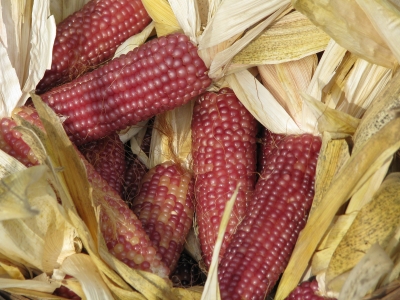
Pink Pearl popcorn
Popcorn is also fun to grow, especially with children around. Growing it yourself also lets you choose a variety you like. You might think popcorn is just popcorn; they all taste the same. Not so! Last year’s crop yield came up a little short (my fault, for not checking the drip irrigation) so, for the first time in many years, I just purchased some to tide us over until this season’s crop becomes ready to eat. The purchased popcorn burst into large, fluffy clouds, but to call the flavor bland would be an understatement. Nothing like the rich flavors of Pink Pearl and Dutch Butter-flavored.
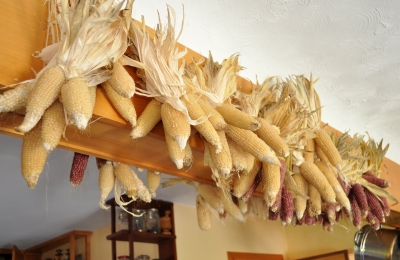
Dutch Butter popcorn
Easy Peasy
Every year I plant two beds of popcorn, each bed 10 feet long by 3 feet wide. Growing popcorn is no different than growing sweet corn, except that you can plant it a little earlier (early May around here) because the lower sugar concentration of popcorn seeds make them less likely to rot.
Popcorn, like any corn, needs good soil; all the beds in my vegetable gardens are moist and rich from drip irrigation and yearly dressings of compost.
I plant popcorn in beds sown five weeks earlier, up the middle of the bed, to peas. By the time pea harvest has wound down, the small popcorn plants are building up steam and need to craving in all the light they can get.
Popcorn and sweet corn need to be isolated from each other as does each variety of popcorn, if you want the varieties to remain pure. My popcorns grow in separate beds that are within 20 feet of each other so they do cross-pollinate a little, which makes for some interesting ears. The sweet corn, though, is in a separate garden. Cross-pollination, in this case, would make for less pop-able popcorn and less sweet sweet corn.
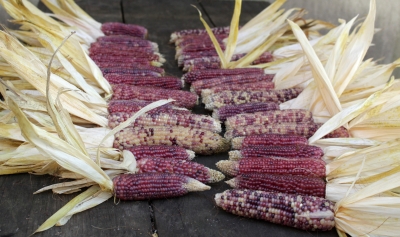
Popcorn mixes
I plant two rows of “hills,” or clusters of plants, down each bed, with 2 feet between hills and 5 seeds per hill. Once seedlings are up and growing, hills get thinned to the best three plants. Yields are about 30 to 60 ears of popcorn per bed (Dutch Butter-flavored variety often yields 2 ears per stalk), and that’s about how much Deb and I consume each year. (The average American consumes about 3 pounds of popcorn per year — mostly in movie theaters, of course.)
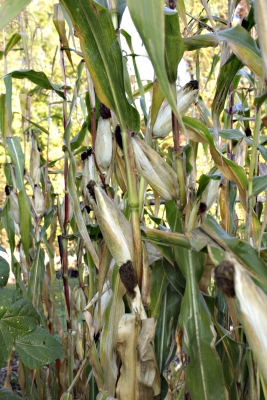
Popcorn ready for harvest
About a week ago, we snapped the dry ears from the stalks of this year’s crop, although there’s no rush to harvest popcorn. Here on the farmden, “processing” entails nothing more than pulling back the husks and tying 2 or 3 ears together to hang and further dry from the kitchen rafter, where they look very pretty and homey.
A Grain (Sort of) That Falls from the Sky (Sort of)
Besides popcorn, another of my successful and satisfying home-grown grains is chestnut. Okay, it’s not really a grain. But chestnut is a unique nut for being high in starch, just like a grain. In many parts of the world, the nuts are dried, ground into a flour, and used to make breads, pancakes, and other foods usually made with grain flours.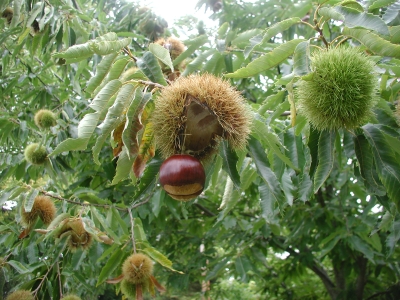
Like popcorn, chestnuts are very easy to grow. Just plant two trees, different varieties. They grow fast, they bear quickly and reliably, and they have an attractive spreading form clothed with leaves that stay glossy green all season until they turn a rich brown color in autumn.
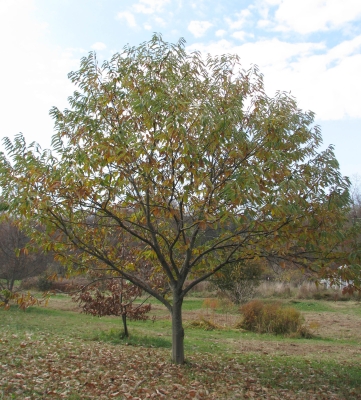
Colossal chestnut in its youth
The only caution is to avoid planting them where anyone will be frequently walking, playing, or sitting because of the spiny burs that drop with the nuts.
American chestnuts succumb to chestnut blight but there are plenty blight-resistant varieties, such as Eaton, Peach, and Labor Day. For 25 years, my slightly resistant Colossal variety tree offered us large harvests of literally colossal chestnuts. Unfortunately, it’s now succumbing to blight. Fortunately, I planted a few trees of different varieties.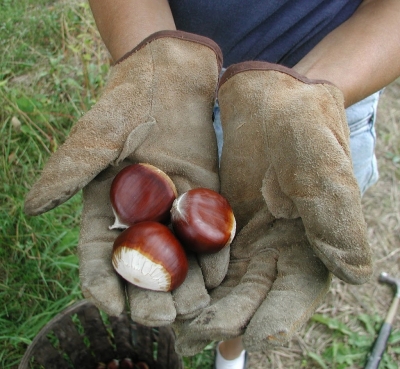
Chestnuts are easy to process. Just pick nuts up from the ground daily during their two-week ripening period. For many people, that’s it; just eat them.
I take chestnut processing a bit further. Some of the nuts have weevils in them or recently vacated from them as evidenced by a small exit hole. I put the nuts in a bucket of water and discard floaters. Then I prevent further weevil damage by giving the nuts a bath, a hot water bath at 120° F for 25 minutes, in a plastic tub with a “sous vide” cooker to maintain heat.
After that, a couple of weeks in the refrigerator allows the nuts to cure as some of the starches convert to sugars and full flavor is developed. At this point, nuts can be frozen, dried or, after being slit to prevent their exploding, roasted in an oven at 450° F for half and hour. Or, of course, roasted over an open fire.
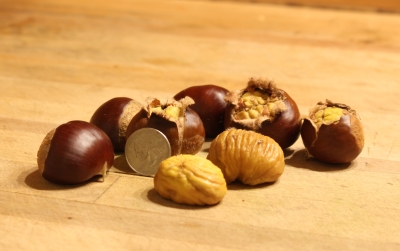
Marigoule chestnuts



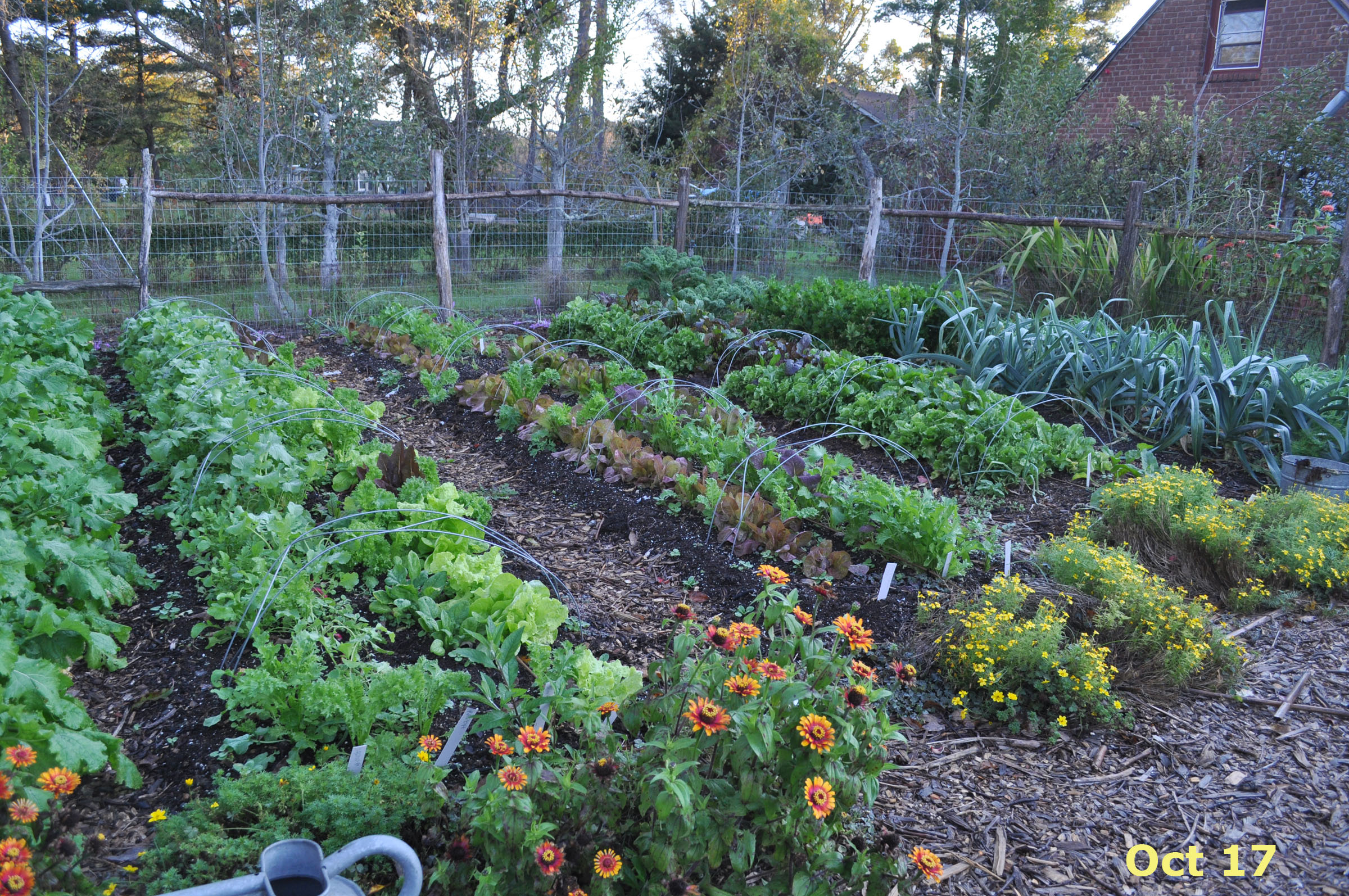
Leave a Reply
Want to join the discussion?Feel free to contribute!